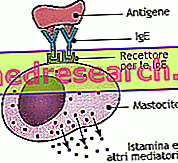[...] the oak was dressed in fog,
giant guardian there
where the darkness from the bushes
with a hundred black eyes he looked.
[Goethe]
Introduction
Patriotic emblem par excellence, the oak was the subject of many poetic and artistic works of poets and painters, both ancient and contemporary. From remote times, the oak symbolizes strength and robustness: the botanical genus ( Quercus ) literally means "beautiful tree" (Celtic translation), while the species that defines the common oak ( robus ) indicates "strength", an adjective suitable for express the robustness and strength of the plant.

The oak, due to its particular solidity to the ground and its majesty towards the sky, has always been synonymous with strength and solidity; in a similar way, the oak is the favorite home of many animals.
Botanical analysis
The genus Quercus (Fam. Fagaceae ) groups all the trees popularly called oaks, and includes many tree species that grow spontaneously in our country. Surely, among the most widespread species in Italy, holm oak, oak, cork oak and English oak cannot be missed.
We are talking about a rustic tree of very impressive dimensions, capable of reaching, sometimes, 40-45 meters in height. The deciduous, alternate lobed or toothed leaves drape the oak of a particularly thick crown. It is not uncommon for the plant to show both female and male flowers: for this reason, we speak of monoecious oak; more precisely, the female flowers are dyed green, while the male ones sport usually yellow robes.
The fruits are acorns, achenes surrounded at the base by a dome of rough and woody scales. Immature, the oak acorns are green, while at maturity they take on a brownish color.
Oaks love drained soils exposed to sunlight; however, the mighty plant also tolerates shaded areas.
Oak: variety
As described above, the oaks in Italy are numerous (there are over 200 species); the most important ones are:
- Oak ( Quercus petraea ): it is mainly used in the building sector, in the manufacture of furniture and in the processing of wine barrels, as well as being widely used for the production of coal. Oak is undoubtedly the finest oak in terms of timber.
- Farnia ( Quercus robur ): this is the most widespread oak in Europe, particularly common in the regions of Northern Italy; it is characterized by sessile leaves, acorns with long peduncles and imposes itself showing a rather irregular bearing. English oak is a plant suitable for symbiotic cultivation with truffles.
- Cork oak ( Quercus suber ): as the name implies, Quercus suber is grown mostly for cork which, abundantly, is obtained from the bark and subsequently used for the production of corks, plywood, insulating material, manufacture of sandals etc ..
- Holm oak or elce ( Quercus ilex ): it is included in the category of the most important evergreen oaks of the Mediterranean, used mostly for firewood. It is an oak typical of areas with particularly hot climate.
Active principles and properties
In phytotherapy, acorns, bark, buds, catkins and roots are used in the oak; mostly condensed tannins (catechins, ellagitannins, proanthocyanidins) are obtained, in an estimated percentage between 8 and 20%. Furthermore, variable quantities of resins, pectins and flavonoids are derived from the oak.
Due to the particular composition of the phytocomplex, the oak is used in phytotherapy especially in the treatment of diarrhea and mild inflammation of the mucosa.
Oak and medical uses
In ancient times, the use of oak for medical purposes focused mainly on the large quantity of tannins, such as antifebrile and anti-hemorrhagic. Still considered for the tannic-based phytocomplex, the oak is exploited for its astringent, antiseptic (disinfectant), vasoconstrictor, antiviral and analgesic qualities, albeit mild.
As we know, the therapeutic value par excellence attributed to tannins is the astringent one: for external use in particular, oak tannins are particularly suitable in the treatment of hemorrhoids, anal fissures and fistulas, precisely because of their healing, antiseptic and vaso-constrictive capacity of these molecules.
Some authors recommend the use of oak extract to treat ailments of various kinds, such as chilblains, hyperhidrosis (in particular, of hands and feet), sebaceous hypersecretion of the scalp and to treat dandruff problems.
Taken per os, the oak extract is used in the treatment of non-specific diarrhea and as a stomachic.
Oak buds are used to regulate intestinal function, as a tonic and stimulant in the stages of convalescence and, lastly, against sexual asthenia.
The astringent and anti-inflammatory therapeutic value in the treatment of leucorrhea is ascribed, instead, to the young roots and the oak acorns.
Toxicity and interaction with drugs
The toxicity of the oak is linked to the tannic component. In any case, the use of oak must be avoided in case of ascertained or presumed hypersensitivity to one or more molecules composing the phytocomplex.
The intake of oak extracts can reduce the absorption of basic pharmacological substances, and the oak tannins precipitate the iron salts.
Oak shortly, summarized on the properties of the oak »



